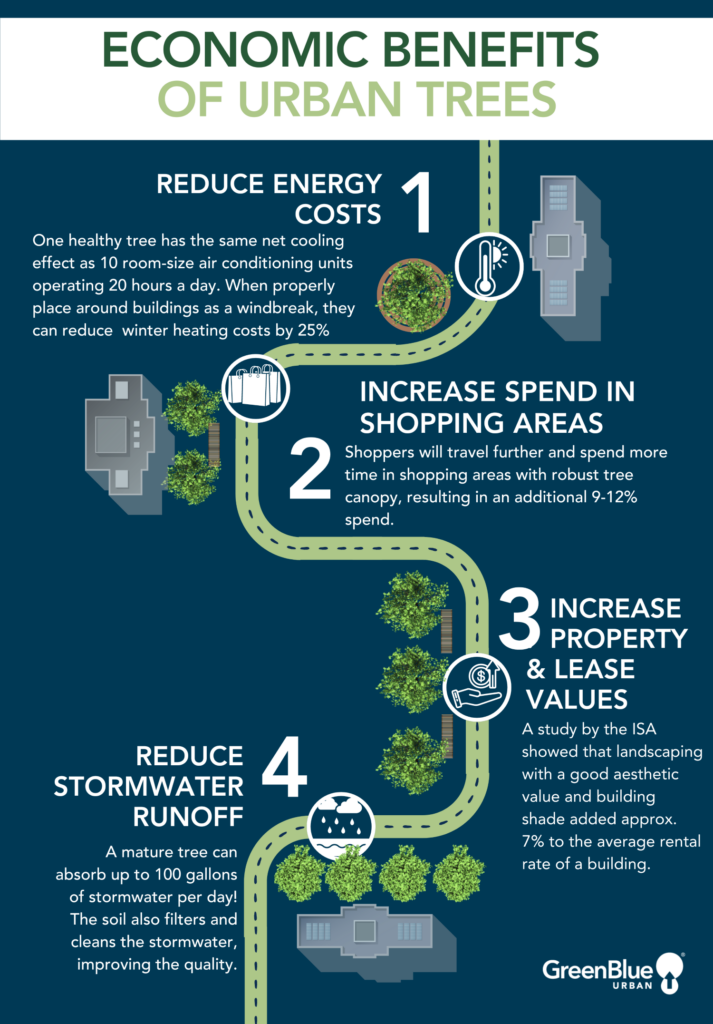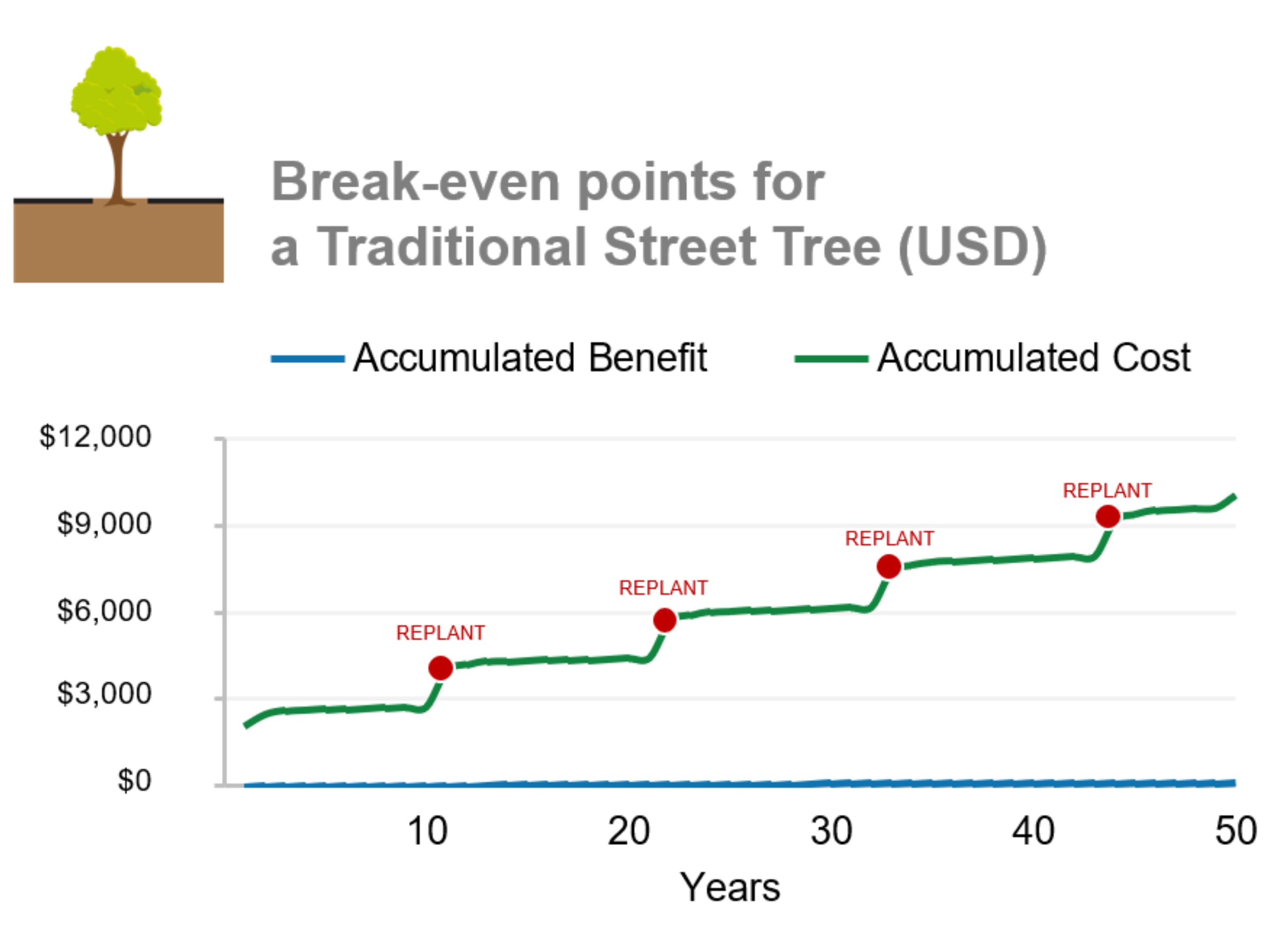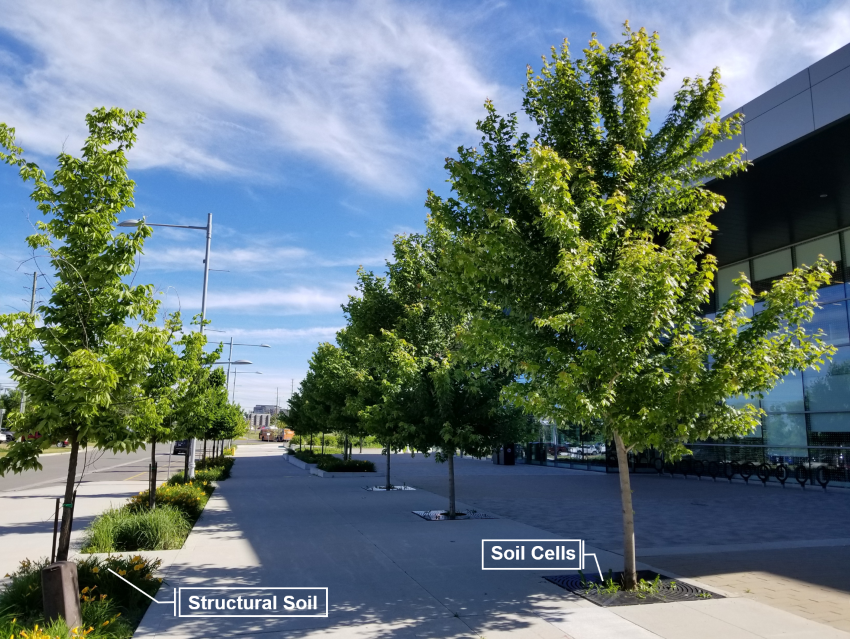Money doesn’t grow on trees. Or at least, it doesn’t grow on trees that are planted haphazardly and die in the first year.
Trees are well-known for providing many amazing economic and social benefits in urban areas. However, when planted without proper knowledge of best practices, the costs can far outweigh the benefits they provide.
In this blog we cover why so many urban trees die, how thoughtful design and planting decisions can change that, and how it impacts the return on your investment.
Bottom line: Right tree + Right place + right way = Return on Investment.
Let’s get more green out of your trees.
THE ECONOMIC BENEFITS OF MATURE TREES
According to the Minnesota Department of Natural Resources, trees can provide up to $7 (USD) in benefits each year for every $1 (USD) invested in caring for them.
There are a plethora of other impressive facts surrounding the specific economic benefits of mature urban trees, such as:

REDUCED ENERGY COSTS
-
- Save up to 25% on winter heating costs when placed properly around buildings as a windbreak.
- The net cooling effect of one healthy tree is equivalent to 10 room-size air conditioners operating 20 hours a day.
INCREASED SPEND IN SHOPPING AREAS
-
- Shoppers will travel further and spend more time in shopping areas with robust tree canopy, resulting in an additional 9-12% spend.
INCREASED PROPERTY & LEASE VALUES
-
- Increase property values by 5-10%.
- Landscaping with a good aesthetic value and building shade added approximately 7% to the average rental rate of a building.
REDUCED HEAT ISLAND EFFECT
-
- Increasing green space in cities by 10% reduces surface temperature by 3.9°C due to water evaporating into the air from trees and other vegetation.
INCREASED TOURISM
-
- Results of a visitor survey conducted at two sites show that tourists’ appreciation of a city’s urban forest has a positive influence on their experiences as visitors.
REDUCED STORMWATER RUNOFF & IMPROVE STORMWATER QUALITY
-
- A mature tree can absorb up to 379 liters of stormwater per day! The soil also filters out physical pollutants and cleans the stormwater via chemical and biological processes. This saves on costs for grey infrastructure.
In addition to tangible economic benefits there are many other valid benefits to trees, such as improving health, calming traffic, noise abatement and improving air quality.
WHY THESE BENEFITS OFTEN GO UNREALIZED
The crux of the matter is that only mature, healthy trees can yield these benefits. Trees must have enough canopy to provide shade, absorb substantial amounts of stormwater and be healthy enough to be aesthetically pleasing. And the quicker they grow, the sooner they will provide these benefits. Without the essential resources, however, trees will be stunted or die, consequently failing to provide any of the benefits listed above.
A common oversight is the underestimation of what trees really require to survive. This leads to the misconception that products like soil cells are just expensive nice-to-haves rather than essential investments. The cheapest, easiest method of installation is therefore preferred – a traditional 4 ft. x 4 ft. tree pit in compacted soil, which falls far short of providing the resources trees require to survive and thrive.

THE MORTALITY RATE OF URBAN TREES
Tree planting initiatives to “increase canopy” are becoming increasingly common. But what % of the trees survive, and how many are providing the benefits they were originally intended to provide? It’s crucial to assess not just the upfront costs but also the long-term viability and effectiveness of the chosen planting method.
In some instances, mortality of newly planted urban trees can reach 25% within the first few months! Only half generally survive 13 to 18 years. That suggests that most urban trees don’t live long enough to provide benefits that offset their economic investment.
It also means they don’t sequester enough carbon to neutralize the emissions from vehicles and tree care equipment used during nursery production, planting, and pruning.
The American Planning Association put it best: “If urban trees are to function as essential green infrastructure, it is reasonable to ask: Would a similar rate of failure be acceptable for traditional gray infrastructure such as street lighting, bridge, or sewage systems?
Tree planting initiatives are ultimately intended to provide socioecological benefits across several decades –not merely to get more trees in the ground”
THE HIDDEN COSTS OF POOR PLANTING
So is the “cheapest” approach genuinely cost-effective in the long run? Even in cases where traditionally planted trees manage to survive, they are often stunted or unhealthy. Their roots, constrained by limited space, exploit the smallest crack and often break out of the tree pit in order to access enough soil and water to survive. This struggle for survival can inadvertently lead to damage to surrounding infrastructure. Not only that, but the resulting shallow and fibrous root systems compromise the tree’s stability, making it much more likely to fall over in a storm.
While initially cost-saving, the traditional tree pit approach may lead to considerable future expenses. These include the removal of dead trees and repairs to affected infrastructure, as well as the costs of re-planting. And if not removed promptly, the eyesore of dead or dying trees may erode public support for urban forestry efforts.
Thinking short-term is likely to incur long-term costs that could have been avoided with more modern planting methods.

IF WE WANT AN R.O.I., WE MUST CHANGE HOW WE THINK ABOUT WHAT A TREE NEEDS TO SURVIVE AND THRIVE
While urban areas will likely never provide the perfect environment for growing trees, the goal is to replicate natural forest floor conditions as closely as possible. These are our top considerations for giving trees their best shot at surviving to maturity in the concrete jungle.
RIGHT TREE
- Typically, a native species is best suited to the local environment.
- Some trees are more resistant to disease and droughts or floods.
- Correct size of tree for the space available – its potential height and width at full maturity should be considered, not its size at the time of planting.
- Trees that don’t produce fruit or litter will be less expensive to maintain.
- Some trees naturally require less soil volume, making them cheaper to install while not sacrificing growth.
- Some trees are quicker growing than others, thus providing a faster return.
RIGHT PLACE
- The space above and around the tree should be considered for the size of the tree when it reaches maturity. We’ve seen trees planted in the middle of sidewalks, right under building overhangs and powerlines or simply planted too close to buildings. Damage to infrastructure could’ve been avoided with a little forethought.
- Root management products should be used when needed, to protect surrounding infrastructure.

RIGHT WAY
- Adequate uncompacted soil volume
- Soil under pavement and sidewalks typically has to be compacted to 95-98%, whereas tree roots will generally only grow in soil compacted to less than 80%.
- While this varies by species, the average tree needs 9-14 cubic meters of uncompacted soil.
- Quality, healthy soil
- We often say, if you take care of the soil, the soil will take care of the tree.
- Irrigation
- Aeration
- Ongoing maintenance
- Especially in a tree’s initial establishment, maintenance is key to providing a strong start in view of long-term growth.
And in order to protect and support surrounding infrastructure, it’s essential that the system have load-bearing capabilities, especially if it is to sustain dynamic loading. Even if you’re designing a predominantly pedestrian area, consider whether it may occasionally need to sustain vehicle traffic, such as emergency vehicles or service vehicles.
USING SOIL CELLS TO MAXIMIZE YOUR RETURN ON INVESTMENT
How much difference does it really make to use soil cells? Do they justify their upfront costs in terms of the substantial benefits they offer?
Below are some comparative graphs that illustrate the difference in returns between traditional trees and trees with soil cells. A standard street tree will never break even despite lower initial costs on account of the tree needing periodic replacement. A RootSpace Airform® tree will break even in year 32.


Even if the trees don’t die when planted using traditional methods, they are often stunted, or develop slower than those grown with sufficient soil volume in soil cells. Consequently, they will take longer to provide return, or never get large enough to provide any significant benefits. Trees in soil cells grow much faster, resulting in quicker returns and an earlier break-even point.
Why do soil cells like RootSpace Airform® make such a big difference? The results are explained in the usable uncompacted soil volume that RootSpace Airform® provides. Traditional tree pits fall short in this aspect due to their small size and high compaction levels – over 80%. Additionally, the rootball occupies the majority of the space in the already-too-small tree pit, resulting in very little to no usable soil volume.
To put it into perspective, the average street tree requires a bare minimum of 6 cubic meters of soil to survive, with an ideal volume of around 30-40 cubic meters for individual trees, or 15-20 cubic meters for shared planting, though this can vary depending on the species.
HOW DO OTHER PLANTING MEDIUMS COMPARE?
In addition to conventional tree pits in compacted soil, urban forestry has seen the introduction of a variety of techniques over the years. These vary in effectiveness but are all aimed at enhancing tree growth in city environments.
This third-party study by Bartlett Tree Labs planted equal tulip poplar trees at the same time in equal trenches. Different planting mediums were installed, and each plot contained the same volume. After one year, the tree planted in GreenBlue Urban’s soil cell system significantly outperformed other structural soils.
Read the full study here.


Gravel-based structural soil
Gravel-based structural soil uses a similar theory to soil cells, yet they differ significantly in composition. Structural soils are predominantly composed of rock—approximately 80%—leaving only 20% of the volume for soil. In contrast, RootSpace Airform® soil cells are nearly all soil. This means that you would need roughly 5 x’s more area of structural soil when compared to soil cells to deliver the same amount of usable soil volume to the tree.
While structural soil may appear more economical at about $149 (CAD) per cubic yard, this figure is misleading. Given that only 20% of its volume is soil, the true cost for the amount of usable soil available to the tree is closer to $740 (CAD) per cubic yard. On the other hand, soil cells offer a more favorable rate of $394 (CAD) per cubic yard of usable soil. Also, using soil cells enables you to go with a smaller footprint while still delivering the same soil volume, leading to additional savings on excavation and installation costs.
Sand-based structural soil
Similar to gravel-based in cost, sand-based structural soil drains well and is capable of being compacted to load-bearing levels whilst maintaining a micro pore structure which can be penetrated by tree roots. However, nutrients tend to drain out rapidly, and achieving the ideal compaction level for pavement stability can be complex. In reality, trees planted in this medium may struggle to reach full maturity.

HOW DO OTHER SOIL CELLS COMPARE TO ROOTSPACE AIRFORM®?
RootSpace Airform® stands out when compared to competitive soil cells, not only for its ease of assembly but also for its high structural strength. These differences are key in driving cost savings and value during the installation process.
Cut Down on Labor Costs & Time
- RootSpace Airform® goes together like big Lego bricks, making it easier and quicker to install than competitive products. This cuts down on labor time and costs during the installation.
- Due to its high structural strength, larger soil cell systems can be driven on and loaded by tracked construction equipment, again making the installation quicker and easier. Competitive products cannot be driven on.
Lower Excavation Costs
Excavation can be one of the most expensive costs associated with tree pits. If you can go with a smaller footprint but provide more soil volume by using RootSpace Airform®, you’re getting the best value out of your excavation costs.
THE BOTTOM LINE
Ultimately, trees may survive without soil cells. The long-term implications, however, include bearing the costs associated with shorter-lived or slower-growing trees, increased vulnerability to storm damage, pavement heave, and potential damage to other infrastructure.
RootSpace Airform® soil cells stand out in the market for delivering the most volume of uncompacted soil. Coupled with our comprehensive ArborSystem, which includes root barriers, an innovative irrigation system, and secure below-ground anchoring, your trees will be given the best chance at establishment and yield the highest possible return in benefits.
With thoughtful planning when selecting the tree species and regular maintenance post-planting, RootSpace Airform® trees are poised for rapid growth, longevity, and substantial economic returns on your investment.
As the old garden saying goes, “It’s better to dig a five-dollar hole for a fifty-cent plant, than to dig a fifty-cent hole for a five-dollar plant.”
